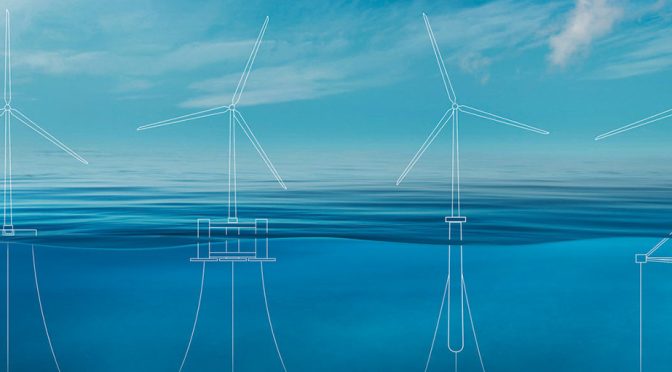Floating offshore wind provides state opportunity for leadership in developing new technologies and markets.
DNV, the independent energy expert and assurance provider, has completed a series of reports for the State of Maine’s Governor’s Energy Office for the Maine Offshore Wind Initiative. The initiative was launched in June 2019 to outline a clear roadmap to develop floating offshore wind in the Gulf of Maine, while ensuring balance with Maine’s maritime industries and environment.
The State of Maine has abundant coastline and some of the highest average wind speeds in the United States, which makes offshore wind an ideal resource to decarbonize its energy supply. However, project development is more complex than other areas already under development on the east coast, because of the Gulf of Maine’s water depths and status as a primary economic driver for the state.
In 2020, the U.S. Economic Development Administration (EDA) awarded a $2.166 million grant to the State of Maine’s Governor’s Energy Office to advance the offshore wind industry in Maine through the development of a comprehensive industry roadmap. DNV was selected through a competitive bidding process to develop a series of technical, socio-economic, and strategy advisory studies to inform the State’s Roadmap.
DNV’s analysis revealed that the benefits of the offshore wind industry to the state are substantial: potential wage earnings of US$2B, the creation of up to 33,000 jobs in the short term during the construction phase of the projects, and up to 13,000 long term jobs during the operational phase of the projects, a potential savings of US$930M in the annual avoided social cost of carbon, and a potential savings of US$4.5M in annual avoided health costs by 2050. Additionally, the electric power generated from offshore wind will be able meet the state’s needs for decarbonized energy when the projects come on-line; however, no large-scale wind farms will be operational in the near term. In the majority of DNV’s scenarios, offshore wind capacity in the Gulf of Maine will accelerate after 2040.
While the development of offshore wind in the State of Maine demonstrates a potential for clear benefits such as job development and health, stakeholders are concerned about negative consequences to the industries and communities that rely on the ocean. The fishing industry, the tourism industry, coastal and non-coastal communities, and the environment could all be impacted in ways that are not currently feasible to estimate, as the lease areas have not yet been finalized by the Bureau of Ocean Energy Management (BOEM).
There is a risk of displacement from harvest areas for fishermen and lobstermen, which can be problematic due to the strong social convention of harvesting only in specific areas that have often been negotiated over generations. The tourism industry could be affected by the perception that visible wind turbines would mar the scenery and “untouched” feel of the coast, although the probable wind farm areas make it unlikely that most people will be able to see them from shore. Coastal community members are most concerned about housing availability and the potential for a rise in electricity rates, but many also acknowledged the risks of climate change and the mitigation effects that offshore wind offers. The roadmap set forth by DNV and other organizations identifies some solutions, like continued proactive communication with affected communities, but also recommends further research into specific areas as lease areas and project development is more certain.

“Offshore wind is an important component to transition to a decarbonized energy industry, and the roadmap prepared by DNV and others will help the State of Maine to build a dynamic and equitable offshore wind industry,” said Richard S. Barnes, region president, Energy Systems North America for DNV. “Floating wind is in its earliest stages and has yet reached commercialization. This initiative provides the State of Maine, as well as other areas where fixed-bottom wind turbines are not feasible, an opportunity to be a global leader in the development of the market and the technology.”
DNV’s 2022 Energy Transition Outlook expects that offshore wind will rise globally from 8% of total wind production in 2020 to 34% in 2050, totaling almost 2000GW. The contribution of ?oating offshore wind is expected to represent 6% of the offshore wind share, with a total installed capacity of about 300GW, requiring around 20,000 turbines. The United States has a goal to deploy 30GW of offshore wind by 2030 and 15 GW of floating offshore wind by 2035, a goal that DNV shows is achievable.
The broad scope of the analysis for these reports required expertise from across DNV, including experts in offshore and in floating wind, transmission grids, stakeholder management and outreach, policy and supply and demand side analytics. The project was a global undertaking, bringing in experts from Norway, the Netherlands, and the United States.
DNV?is an independent assurance and risk management provider, operating in more than 100 countries. Through its broad experience and deep expertise DNV?advances safety and sustainable performance, sets industry standards, and inspires and invents solutions.
Whether assessing a new ship design, qualifying technology for a floating wind farm, analyzing sensor data from a gas pipeline or certifying a food company’s supply chain, DNV?enables its customers and their stakeholders to manage technological and regulatory complexity with confidence.?
Driven by its purpose, to safeguard life, property, and the environment, DNV?helps its customers seize opportunities and tackle the risks arising from global transformations. DNV is a trusted voice for many of the world’s most successful and forward-thinking companies.
In?the?energy industry
DNV provides assurance to the entire energy value chain through its advisory,?monitoring, verification, and certification services.?As the world’s leading resource of independent energy experts?and technical advisors, the assurance provider helps?industries and governments to?navigate the many complex, interrelated transitions taking place globally and regionally, in the energy industry. DNV is committed to realizing the goals of the Paris Agreement, and supports?customers?to transition faster to a deeply decarbonized energy system.


